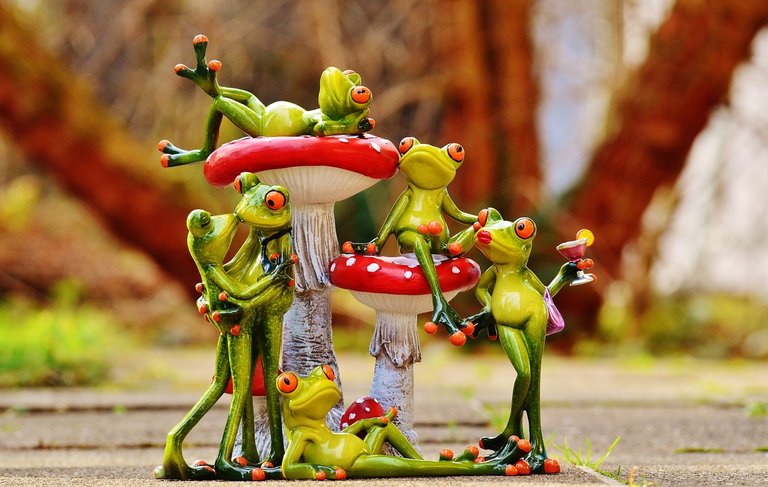
You may have seen them, eaten them, or been told that certain kinds are poisonous. But what is a mushroom? It’s not an entire organism. It’s merely the fruiting portion of a kind of fungus.
Most of the organisms that produce mushrooms grow beneath the soil or beneath some other substrate like leaves or wood chips. Beneath the surface, the organism sends out strands of mycelium. If you have ever grown mushrooms or dug underneath them, you might have noticed the thin white strands of fiber that are part of this fungus. They look slightly like fibrous mold.

Mushrooms are a sign of healthy soil. In fact, if you pick up a cupful of healthy garden soil, there might be MILES of mycelium strands just within that cupful of soil (no, don’t eat it). These are amazing organisms. Molds and yeasts also belong in this large family or organisms along with mushrooms.
If you’ve every grown mushrooms from a kit, you might have learned that some – like oyster mushrooms – can grow in just about any substrate, such as sawdust or used coffee grounds. Other kinds of mushrooms grow in hardwood, either living or (more commonly) dead or dying wood. In fact, that highlights their main importance in a healthy ecosystem, which is to reuse and recycle nutrients back into the soil.
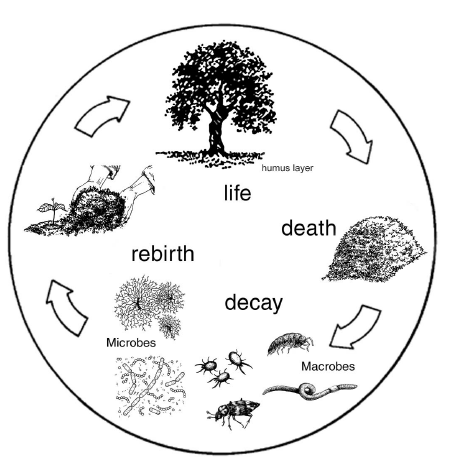
When old plant or animal matter decomposes (as with compost, which is old food waste), fungus plays a role in breaking it down into smaller bits. Within months or years, depending on the items and the climate, most items will return to the earth and look much like the soil around them. This is thanks in no small part to the work of the molds and yeasts and mushrooms, along with bacteria and other organisms like earthworms, which break it down into components that can be used again by plants.
In a few months’ worth of walks through the woods, I have taken a number of photos of mushrooms. Since this has been the warmer part of the year, there aren’t many growing on the ground, which has been mostly dry. But here are a couple of 'shrooms that I found growing on a suburban lawn, under a shady tree and near a sprinkler head that supplies moisture.
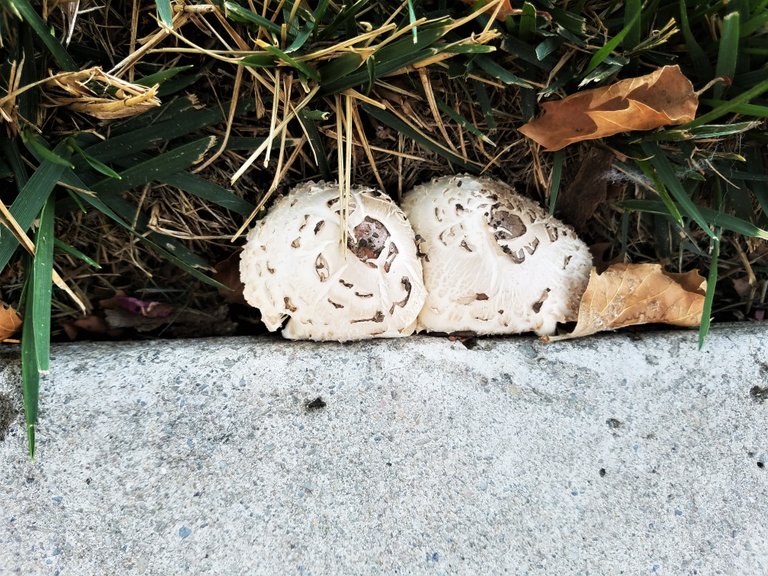
Most of my pictures here are of fungi on fallen tree trunks. This one looks like it was once a fir or pine tree. Now it is covered with ‘shrooms.

Here is a tree that fell over. But it probably has no mushrooms on it because it kept growing after the fall. Look at these branches growing upwards towards the light.

These holes were made by woodpeckers. I’ve posted about woodpeckers before, but haven’t seen any recently. These birds make holes in the trees for insects to live in or in which to stuff acorns and other nuts; either way, it becomes an easy meal in the future. They usually choose old and dead tree trunks for this also, so they do their part to help break down the old wood over time.

Here are some fallen trees; the largest one is a redwood tree. The last of these pictures shows a log with some crusty white growth, which is probably some fungus or lichen. More about lichen shortly.


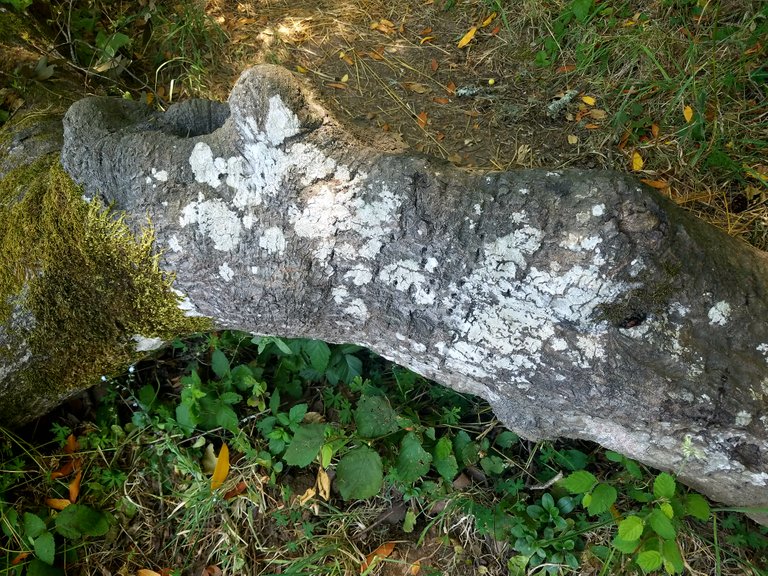
Now let’s see what’s growing elsewhere on these logs.

Some of these look like shelf mushrooms, which is my generic term for them.
Others start to look like sea slugs or melting ice cream sandwiches. But I sure wouldn’t eat them.



Since I’m not an expert, I have no idea what kinds of fungus I’m looking at here. Eating one of these might kill you or it might cure cancer. Science has barely tapped into the possibilities as far as using mushrooms for health, but some of them are quite toxic as well. I’ll keep my distance.
Here is a cypress tree growing right near the ocean. As you can see, there are ferns and mosses growing in the branches. They may be epiphytes, which grow there with available soil and water, and do not hurt the tree. Of course, it’s possible that a plant on a branch could be parasitic in that it takes nourishment from the tree itself.

Below the ferns, you can see some lighter colored lichen on the branch. Lichen is a community of organisms that grows together; it may include fungus, algae, and bacteria which exists in synergy.
Finally, check out this cliff. The soil on the hill eroded to expose the bedrock underneath. On the rock face, you can see another community of lichen. This time, it’s orange rather than light green or white.

And rather than breaking down wood, this community of fungi and other organisms is working on the rock itself. Perhaps it had some small role in creating this crack in the rock. And that, in turn, provides a spot for something else to grow.

This small salal plant is quite happy to have gained a foothold here. Native Americans used the berries of the salal plant for food. Birds, hikers, raccoons, and even bears enjoy these berries also.
I did not get a picture of salal berries, but here is a blackberry bush that was growing near some of the shelf mushrooms, quite possibly using some of the nutrients that previous fungi helped to recycle back into this soil. Animals and people also pick the blackberries when they get darker and ripen.
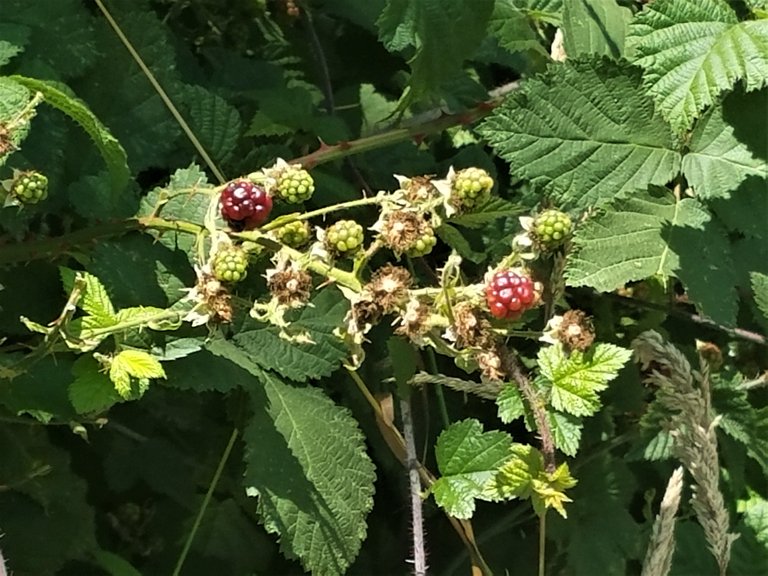
When the plant leaves fall or the berries are deposited on the ground, another fungus plays a role in decomposing them. And the cycle begins again. Life is amazing.
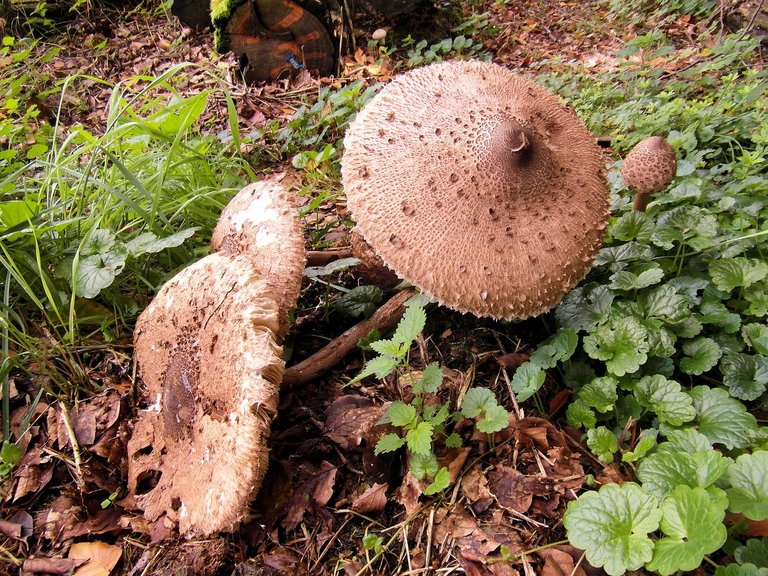
All photos by the author except for top picture (frogs), second picture (mycelium), and last picture (mushrooms in soil). Those three are public domain.
In the lab of microbiology we used to study on fungus growth by using experimental method.. This post remind my old days. Crusty white fungus/lichens look interesting.
Great, and you took the pictures.
Circle of life. We all share the same elements, whether here or out in the universe. Whether animal, plant, insect or deep sea creature, we use the elements, return the elements and then return again and again and again. It's a brilliant system!
can it be eaten? I don't know if this is in my area. What is certain is that it has opened my eyes, namely the world is very wide. thank you
What I like about fungus is that some of them can be used as food but sadly most are poisonous so some people stays away from it @donkeypong But at least we can buy the good stuff from the supermarket and they are great to eat as we do not have to worry about pesticides.
Mushroom is a decomposer in biology, they are responsible for decomposing dead organic matters, if not for all this kind of this decomposer, the earth would'av been full of undecomposed matters with unbearable odour.
Its an example of fungi, named botanically as
Agaricus bisporus..
Its very delicious, hehehehe
I like the post @donkeypong
Thanks for your comment.
To be very honest I don't like them, But i want to ask you a question, Is this the same mushroom that we see on our pizza topping?
Hairy mushrooms. :) Probably not quite the same, but related.
It is impressive the role so important that nature plays to make possible that fungi grow because if the soil does not have the necessary nutrients can not grow there, besides that everything is a matter of cultivating them properly! Thanks for the information is very useful :)
Mushrooms are quite healthy and tasty too.
Besides looking ugly mushrooms are highly nutritious.
And looks like you have worked hard for these photographs.
Really amazing photographs and detailed description of mushrooms.
Thanks for the comment. Glad you liked the post.
I have heard them that they are very beneficial for our health. Is it right?
Some are beneficial. Others are poisonous. One needs to be careful. :)
amazing... so much we dont know... all i do with mushroom is cook and eat....i will look for "salal berries"
Salal grows in cool, wet places, probably not your part of the world. Even here, most people have never heard of it. I'm sure you have some other great fruits where you live.
Sure we do....
Coincidentally, I am actually taking “olu” here. That is what it is called in my dialect. Lol
Amazing plant life cycle. Informative post as always. Thank you sir
You won't believe it just last week I and my brother were planning on starting a mushroom farm, i even made a ulog post on it last week. Mushroom is called "Olu" or "Osun". We've already made plan for the spawn subtrate, watched a lot of video, mushroom also grows here too, but no dead wood around, woods have given way to urban civilization. The one we have now is cultivated and sold at high price in shoprite(mall)
https://steemit.com/ulog/@botefarm/ulog-day-20-starting-a-mushroom-farm
That's really nice. Good luck with it.
This is how you can find infinities of fungi I think of many species, I have seen them a lot in wood or in trees
I have been in these places are usually humid because of the climate that there has been heard also that we should not eat all the mushrooms that we find for this surely we should see some classes and know what to eat or not
It gives me a bit of fear sometimes to touch them in case they are poisonous I prefer to see them but I like this experience @donkeypong
Yes, stay away unless you know which ones are safe. I look, but I don't touch, unless it's sold at the store. :)
Hello Friend how are you? just like you are not an expert mushroom but your interesting publication and your excellent photos made me investigate a little
It is important that you never consume a mushroom if you are not sure that it is fully edible. You can not even trust when you see them in street vendors, although those who collect them for sale have knowledge about their classification, sometimes they can make mistakes and include some toxic specimens that could affect your health or make you have a hard time. . If you want to go out and collect your own mushrooms it is necessary that before you consult a guide that retrieves data of the varieties that grow in your region.
I do not consume any type of mushrooms but we must be very careful when we find them there are certain ways to distinguish between edible and hallucinogenic.
Never try to identify an edible fungus by its taste or smell, doing this can cause poisoning or allergies depending on the species that you have approached to check your condition. Although you can distinguish them because some poisonous varieties are easily destroyed by touch.
When cutting a fungus, leave it upside down so that it releases its spores. Normally, the spores they release are white, brown, black or yellow. In isolated cases they are blue, green or red, although if you do not feel safe eating it, better leave the fungus where you found it.
Do not trust the myth that all white mushrooms are edible. In some places like Ohio, mushrooms with a higher concentration of poison or other dangerous substances are white.
Good point. Even breathing a poisonous one may release some spores, so I wouldn't touch or step on them unless I know it's safe.
It's amazing how fungi if we are not careful cause envennamiento you have to be alert, there are people who can not see them because they get their attention and want them as if they were flowers
Incredible compilation of detailed information. Lovely photos. Incredible indeed
Na wa o...lol
Na hustle baba. No reasom am. Greetings my friend
Mushrooms are edible and some non-edible
It is cooked as a soup sauce in my country with lovely condiments accompanying it.
I have heard stories (True life) of some folks who died on consumption of Mushrooms.
As great as it maybe most probably as an ideal meal for vegeterians, it is pertinent to be careful on how to distinguish toxic from non-toxic mushroom.
I so agree to this quoted text of yours as presence of Mushrooms validate a soil to be healthy.
How can a toxic and edible mushroom be distinguished?
You'd need to consult with experts or a guidebook/site that has goo pictures of the edible and dangerous ones. I'm not an expert, so I only eat the soup ones myself.
Quite true that some mushroom might kill us while others are highly nutritious. I once heard that there is something like a "general" way of identifying those that are relatively safe for eating.
As for the medicinal value of mushroom, you capped it all when you said science has barely touched the surface when it comes to mushrooms, however, I believe that with time, more research will be done on it.
Due to the way fungi easily drops spores and sprouts, their growth becomes common.
Probably true. Where I live, I've heard there are only one or two really badly poisonous ones, and those can be avoided, but there are still stories in the news every year about people eating the wrong ones and going to the hospital (or worse), so I'd rather not take my chances, and I only eat store-bought ones. Look but don't touch, unless you're a knowledgeable forager!
Nowadays we can see any amount of fungus, whether it is in nature, some of it is also used in food. I understand that hundreds of species of them are created every time. We must be quite careful with them as many are deadly and highly poisonous, others are just the opposite. Very beneficial to fight some disease or to improve some neuronal capacity.
I came here for the frogs and learned something along the way :^)
Come for the frogs, stay for the mold.
Mushrooms are absolutely fucking crazy things. You're not kidding when you say they can either kill you or cure cancer someday. I really hope scientists start researching shrooms/fungus more heavily in the future. I find it really fascinating how different the effects of consuming specific ones can be. And, it seems like most of them give nothing but benefits.
I've heard consuming Cordyceps in a big enough dose daily can improve your libido and sexual performance. Reishi's help you sleep more soundly at night, and apparently Lion's Mane can cause you to have vivid dreams if you consume a big enough dose before going to sleep. There seems to be a myriad of effects between all the different types of shrooms out there.
Hell, you can do even weirder, useful things without consuming them. I remember on the Joe Rogan Podcast he had a guest on that talked about how the Japanese apparently used fungus's to make their railway system more effective. They basically used the fungus as a mapping way as it grew to plan out the system. It was some really interesting information. He also talked about how Portabella mushrooms contain a carcinogenic enzyme unless you cook them at a very high temperature, so never eat them raw. Apparently he was threatened by a company not to talk about it in depth, however, which sucks. I learned a lot of weird things about shrooms in that podcast, now that I think about it, haha.
(Also, I really enjoyed the pictures that you actually took. Kinda makes me want to go out and start checking around for mushrooms in my area, lol.)
That's incredible. I'll have to look up some of those stories and learn more, as I haven't heard all of them before. Yes, I think Cordyceps and Reishi both have some strong properties, according to natural health practitioners.
If you have two hours free to listen to this, I would highly recommend it. Lots of information and discussion on mushrooms in this podcast with the mycologist who was speaking about the Japanese train system and Portabella mushrooms.
There's lots of interesting info floating around on fungus, I'm really surprised we don't see more mainstream reporting on the possibilities of what we could do with them.
Hello, how are you? today I learn a little more fungi I like plants and everything that has to do with nature every day I am learning more
I've seen most of those mushrooms on the stem of a tree say that some are edible and others could be very poisonous or bad for our health could do us much wrong
I prefer to touch it or just look at it, I hope to see some day one with a lot of color like the first photo where the frogs are yet I have not seen one so colorful
although I confess I do not like mushrooms in food or pizza but if they do not have a flavor that stands out but I do not prefer to admire them
Those colorful ones can be toxic, I think, but I've only seen them once or twice in person (rare here). Yes, look but don't touch.
Mushroom is delicious. Especially in Pizzas.
Well nice to see you writing a sciency post Tom :)
I'll have to tag them #sciency . I leave that other tag for the real science people.
:D Sciency... it will slowly catch on.
You think I'm joking, but I'm going to try it...for the amateur scientists among us.
Why would you assume I think you are joking? It's a nice idea Tom. I am all for science in any capacity.
Mushroom is magical, some people love it (like me), some people hate its texture. I love it in soup or deep fry them. In forest here in Europe, you find so many of them.
Some of them are very edible, delicious, and healthy, but beware of the others!
I once read a story of a women living in the forest and she has the skill to tell edible ones apart from other ones. Great skill, I believe :D
Yes, it is a great skill. Some people are real foragers. Here, we have stories every year, though, about people who go out into the wood and end up in the hospital because they ate the wrong mushroom. So you have to be sure.
I feel bad for those :(
I guess I'll leave mushroom picking thing to the expert and just eat...
I love fungi, I started a photography tag last year called #fungifriday but haven't done anything more on it cos fungi doesn't grow in the UK at this time of year. Once it starts getting damp again (if it ever does), I am going to go out in search of some lovely fungi.
Interesting fact.... Toadstools will normally grow really close together. That's because, in order to reproduce, they dont need mushroom.
Baboom tish.
Nice. I'll look for that tag when things get damp.
That's some great information about mushrooms so a mushroom is a good sign of a good soil? Now I know and I think its pretty by the way Sir @donkeypong I'm new here to steemit so hope to get along with more amazing people like you here. And have more exchanging of knowledge with you :)
Welcome and thanks for the comment. Hope you like it here!
Yeah sir @donkeypong I started to feel the good vibe and the warm welcome of a lot of users here. I'll keep track of your blogs it seems very interesting maybe I could learn a thing or two from you.
I thought you seemed like a fungi Tom!
Gotta have fun. No one likes a depressingi.
Hola @donkeypong, hay un hongo que recuerdo mucho que se parece a un coliflor para hacerte la comparación, pero es más baboso, recuerdo que eso mi mamá lo fermentaba unos tres días y luego se le agregaba leche y azúcar.. que cosa tan buena ese hongo (era el nombre que se le daba) ..Me encantaba demasiado y me desesperaba cuando no los veia fermentados jajjajajja... Estuve leyendo algo y lleva el nombre de Kéfir.
Oh yes, kefir and other probiotic cultures are great. Some people call them a mushroom also!
It is important to note that most mushroom are saprophytes; meaning they live on dead organic matter
Geez!....:)...
In my village we can see mushroom and fungus and some people eat mushroom
Your blog is very informative we promoted your blog and your name on our steemit Instagram community here is a link https://www.instagram.com/p/BmFwrnkAv-L/?utm_source=ig_web_copy_link
Shiitake mushroom: Studies have shown that Shiitake mushroom is readily available and is tasty, has several anti-tumor properties, helps reduce cholesterol, and has anti-viral properties. Inoki mushroom Enoki has a mild flavor and is characterized by its anti-cancer properties. Jelly mushroom: The jelly fungus of the Tremella species, called the ear mushroom, is considered edible.
fungus. The body of the mushroom in called mycelium and its individual parts are microscopic. I heard before mushrooms has better healthy ingredients for preserve cancer and other worst diseases. Mushrooms are good source of B vitamins, niacin and highest protein content. Lots of fungus & lichens growth up on the hardwood & dying wood. I don't know why. But there are has better environment for growing them. Your outstanding photography collections showing much better where's places nicely growing them. Thanks again for your valuable content Tom.Hello @donkeypong, Another best supporting blog for educative citizens. You given most important things about
Nos provee de la fuente de alimentación necesaria para poder nutrirnos.
Adicionalmente a eso brinda a todo el ecosistema de una diversa gama de vegetación que cubre la tierra, suelos y aguas profundas de los mares.
Hongos, hay muchos, debemos seleccionar "cuales" podemos y debemos usar para lo que necesitemos.
Por ejemplo para hacer "pan" necesitamos levadura, y para colocarle a la pizza necesitamos "champiñones" y ambos son hongos distintos y diversos.
Gracias @donkeypong por compartir tus conocimientos con todos nosotros.
It provides us with the necessary power source to be able to feed ourselves. In addition to that it provides the entire ecosystem with a diverse range of vegetation that covers the land, soils and deep waters of the seas.
Fungus, there are many, we must select "what" we can and should use for whatever we need.
For example, to make "bread" we need yeast, and to put it on the pizza we need "mushrooms" and both are different and diverse mushrooms.
Thank you @donkeypong for sharing your knowledge with all of us.
Interesting information, very complete, excellent photos, made me remember the subject of Earth Science at the University, I made a presentation on that subject, mushrooms are widely used in all aspects and we can get diversity from them. Nature is wonderful
I actually made a post about this discoloration that appears on most of the trees in the place I really love to visit every single month. No matter whether it’s winter or summer. Each time this place is special, but at the same time it’s sad. I’m really concerned about the trees and it’s happening all over. I would say this organism appears on 80% of trees at some point. It’s actually called lichen. They say it’s harmless to tree itself. However, where lichen is found on tree, it means this particular tree is sick mainly from its roots. Few months ago I made a throughout search to find out a bit more about it and all I know is that lichens growing on trees are actualy a relationship between two organisms: fungus and algae. This fungus grows on the tree and can collect moisture, which the algae needs. The algae in return can create food from the energy of the sun, which feeds the fungus. The reason why it appears on the tree is because the tree itself doesn’t grow anymore. Have you ever noticed lichens growing on the rocks? That’s because rocks don’t grow, it’s perfect place for lichen to grow. Exactly the same comes to trees, they are slowly dying 😔.
Great article @donkeypong! However, since I’ve immigrated to US, I haven’t picked any wild mushrooms from the forest. Not even if it looked ok. I’m not sure why, but something has changed in my mind. While living in my country in Europe where I was born, we were picking up all kind of mushrooms every single year. We were not worried at all about getting poisoned. As I mentioned, in US it’s not something I would do. Instead, I just simply buy it from the store.
This is National-Geographics-quality post. Beautiful images and text. The author is evidently in love with nature.
My two cents: if one doesn't maintain one's house, fungi will begin to conquer it also. Besides, another interesting fact is that fungi belong to their own kingdom of living creatures, they don't belong to the plants kingdom as many people would believe.
omgeez, I never really had interest in these kinds of posts. but your post is an atomice bomb of amazing information and interestesnezzzz, your post kept me reading, I'm impressed.
This post has been rewarded with a upvote ofcourse and a resteem! :D
I did not know that some of them could cure cancer...
Not all mushroom are poisonous, mushroom does not have chlorophyll, it has several benefits..
A well formatted and educative post @donkeypong.. Well done
Nice Article though .👌
Posted using Partiko Android
We just had a lunch conversation at work a few days back discussing whether mushroom is a vegetable. And sure enough, by definition, it is not.
Mushrooms are both types toxic and non-toxic. But it depends on the place of their growth.. But eatables mushrooms are professionally cared by farmers whiles poisonous mushrooms are grow nearby seas.
As per my personal knowledge.
Posted using Partiko Android
mushrooms also can be very tasty vegetables, thanks Tom for the informatif post
it's miles cooked as a soup sauce in my united states with lovely condiments accompanying it. i have heard stories (authentic lifestyles) of a few those who died on intake of Mushrooms. As outstanding because it perhaps maximum possibly as a great meal for vegeterians, it is pertinent to be cautious on how to distinguish toxic from non-toxic mushroom.
I loved your post there is data that I did not know about fungi and I love photo 2 and 6 very interesting your post. :)
plants that are full of nutrients, and can also be beneficial for humans and animals, great posts
This is very informative post about fungus and frog. I have picked a lot of incredible things. In short it's a great post.